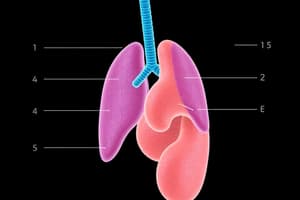Podcast
Questions and Answers
What are the levels of organization in the body?
What are the levels of organization in the body?
Chemicals, cells, tissues, organs, systems, and organism (CCTOSO).
What is homeostasis?
What is homeostasis?
It refers to the balance that is maintained by our physiological processes within a range given towards a set point.
What is required for all our physiological mechanisms?
What is required for all our physiological mechanisms?
The use of energy (ATP).
What is the structure-function relationship?
What is the structure-function relationship?
What is the function of communication in the body?
What is the function of communication in the body?
What is the role of the cardiovascular system?
What is the role of the cardiovascular system?
The nervous and endocrine systems have the greatest impact on all other systems.
The nervous and endocrine systems have the greatest impact on all other systems.
What are the three basic components of a control system?
What are the three basic components of a control system?
What is a negative feedback loop?
What is a negative feedback loop?
What are ligands?
What are ligands?
How many particles are in a mole of any substance?
How many particles are in a mole of any substance?
What is molarity?
What is molarity?
What is hydrostatic pressure?
What is hydrostatic pressure?
What is osmotic pressure?
What is osmotic pressure?
Which of the following is a non-organic molecule in our body?
Which of the following is a non-organic molecule in our body?
Which of the following are the most abundant?
Which of the following are the most abundant?
Carbs are the most complex, they are non-polar and water soluble.
Carbs are the most complex, they are non-polar and water soluble.
The plasma membrane, also known as the phospholipid bilayer, is made out of what?
The plasma membrane, also known as the phospholipid bilayer, is made out of what?
What are the two main properties of every receptor?
What are the two main properties of every receptor?
What is specificity?
What is specificity?
What can warmer temperatures cause?
What can warmer temperatures cause?
What are the four main tissues in our body?
What are the four main tissues in our body?
What are the two main cells of neural tissue?
What are the two main cells of neural tissue?
What structure is the 'receiving' end of a neuron composed of?
What structure is the 'receiving' end of a neuron composed of?
What is the axon hillock?
What is the axon hillock?
Flashcards
Levels of Organization
Levels of Organization
Hierarchy of structures in the body: Chemicals, Cells, Tissues, Organs, Systems, Organism.
Homeostasis
Homeostasis
Balance maintained by physiological processes within a range around a set point.
Energy in Physiology
Energy in Physiology
Physiological processes require energy (ATP) obtained from glucose or aerobic respiration.
Structure-Function Relationship
Structure-Function Relationship
Signup and view all the flashcards
Communication in Physiology
Communication in Physiology
Signup and view all the flashcards
Control System
Control System
Signup and view all the flashcards
Negative Feedback Loop
Negative Feedback Loop
Signup and view all the flashcards
Positive Feedback Loop
Positive Feedback Loop
Signup and view all the flashcards
Ligands
Ligands
Signup and view all the flashcards
Receptors
Receptors
Signup and view all the flashcards
Osmolarity
Osmolarity
Signup and view all the flashcards
Tonicity
Tonicity
Signup and view all the flashcards
Hydrostatic Pressure
Hydrostatic Pressure
Signup and view all the flashcards
Osmotic Pressure
Osmotic Pressure
Signup and view all the flashcards
Types of Organic Molecules
Types of Organic Molecules
Signup and view all the flashcards
Cellular Permeability
Cellular Permeability
Signup and view all the flashcards
Specificity of Receptors
Specificity of Receptors
Signup and view all the flashcards
Affinity
Affinity
Signup and view all the flashcards
Isoforms
Isoforms
Signup and view all the flashcards
Up-Regulation
Up-Regulation
Signup and view all the flashcards
Down-Regulation
Down-Regulation
Signup and view all the flashcards
Neurons
Neurons
Signup and view all the flashcards
Dendrites
Dendrites
Signup and view all the flashcards
Axon
Axon
Signup and view all the flashcards
Synaptic Terminal
Synaptic Terminal
Signup and view all the flashcards
Epithelial Tissue
Epithelial Tissue
Signup and view all the flashcards
Connective Tissue
Connective Tissue
Signup and view all the flashcards
Muscular Tissue
Muscular Tissue
Signup and view all the flashcards
Neural Tissue
Neural Tissue
Signup and view all the flashcards
Study Notes
Levels of Organization
- Body systems are organized into levels: chemicals, cells, tissues, organs, systems, and organism.
- Chemicals combine to form organelles, which regulate processes within cells.
- Cells combine to form tissues with a common goal.
- Tissues combine to form organs with specific functions.
- Organs working together form organ systems.
- Organ systems interact to maintain overall body function.
Physiological Themes
- Homeostasis: Maintaining internal balance around a set point.
- Energy: Cells use ATP (energy) for physiological processes.
- Structure-Function Relationship: Structure dictates function in the body.
- Communication: Chemical and electrical signals coordinate body systems.
Homeostasis
- Homeostasis is a dynamic process, constantly adjusting to maintain an internal environment.
- The body has set points for various parameters like pH, but fluctuations occur due to everyday activities.
- The range of acceptable fluctuation depends on the parameter.
- Setpoints and ranges help keep the body in a healthy, stable state.
Energy
- All physiological processes require energy (ATP).
- Energy stored in chemical bonds and concentration gradients.
- Energy used to convert from potential to kinetic energy.
- Energy needed for processes like respiration and movement.
Structure-Function Relationship
- The structure of biological systems determines function.
- Molecular interactions and the organization into compartments are essential for function.
- Mechanical properties of structures also contribute to overall function.
Communication
- The body uses chemical and electrical signals for communication.
- Signals direct actions and maintain balance.
- Signals are separated into chemical and electrical signals.
- Systems communicate to keep body in homeostasis.
System Interactions
- The cardiovascular system plays a critical role in affecting other body systems due to its proximity and exchange of materials.
- It ensures the coordinated functioning of all body systems.
- It exchanges materials between compartments (ECF and ICF).
Control Systems
- Control systems maintain homeostasis by sensing changes and responding appropriately.
- Input signal (stimulus) -> Integrating center (receives signal and processes)->Output signal (response).
- Control systems can include feedback loops to regulate processes.
- Negative feedback loops reduce or stop a stimulus' effect.
- Positive feedback loops increase the effect of a stimulus.
Chemical Components of the Body
- A mole is 6.02 x 10²³ particles, regardless of molecular identity.
- Molarity is the concentration of a substance in one liter of solution.
- Osmolarity is the total concentration of solute particles.
- Dissociation increases number of particles in a solution's osmolarity.
- Equilibrium is maintained between fluids and compartments; cells regulate internal environment.
Protein Binding
- Receptors are specific for the molecules they bind with.
- Affinity determines how easily a ligand binds to a receptor.
- Ligands can be isoforms; similar shape, but can be agonist or antagonist.
- Activation, modulation, and competition influence how a protein binds.
Regulation Factors
- Temperature, pH, factors dictate speed and efficiency of reactions involving ligands and receptors.
- Receptor concentrations, ligand concentrations, and signal pathways influence cellular functions.
- Regulatory factors affect the speed and amount of activity for ligands and receptors.
- Proper functioning of cells and systems depends on regulatory mechanisms.
- Concentration of ligand or receptors can affect response of system
Types of Tissues
- Four main tissue types: epithelial, connective, neural, and muscular.
- Each type has specific structures and functions.
Studying That Suits You
Use AI to generate personalized quizzes and flashcards to suit your learning preferences.




